I observed an adult Slaty-backed Forktail with a juvenile in Cameron Highlands at ~1,600m ASL on 30th June 2022. They were foraging along a small road adjacent to primary forest; the nearest stream was about 100-120 meters away.
To offer some context to this observation:
It had been a very misty, wet and cold morning. Visibility had been poor with a constant steady downpour. Streams were overflowing and rushing. It took some time for the sun to come out and warm the area. There were many puddles of water on the road edge. I suspect some insects may have come onto the tar road for warmth and the streams were too overflowing for easy foraging.
The adult and juvenile were foraging exclusively on the road surface. They appeared to be feeding on small insects (image 1 of prey in juvenile’s beak); prey was too small for me to identify.

The juvenile was being fed by the adult (image 2), as well as at times self-feeding. They would walk/run or occasionally hop along the road looking for prey, with the adult in the lead. At times, when I got too close (~5-6 meters) they would fly a little further or run forward to continue feeding. While foraging, the adult bird would call out almost continually; I wonder if these were contact calls with the mate? I did not see the other adult and wondered if it was feeding another juvenile (brood division for post-fledging care).
Engilis, et al (2021) have shown that the diet of Slaty-backed Forktails can be very diverse, comprising aquatic insects, terrestrial insects (including butterfly, moths, dragonflies, arachnids), fish and mollusks. Prior opinions that the birds forage exclusively along streams needs to be revised.

I had an opportunity to observe the juvenile’s plumage and compare it with the adult’s. Some observations on the juvenile cf adult (see composite image 3):
- Lacks the frontal/forehead white patch.
- The lores are white; black in adults.
- The throat is grey-white; black in adults.
- The breast is grey-white fringed with black (almost like scales); white in adults.
- Juvenile’s head and mantle are lighter than the adult’s slaty grey.
- The juvenile had a small gape.

I tried to obtain some flight images to see tail plumage differences (see images 4 of juvenile in flight and in image 5 the adult is ahead/in front in the composite image). The juvenile tail length appeared shorter, was whiter at the rump, and the white bars were more prominent. Note that the adult’s tail was in moult.


I also saw another juvenile, self-feeding on insects found on the roof of a house. See photo 6.

References:
- Wells, D.R. (2007). The birds of the Thai-Malay Peninsula: Vol. 2 (Passarines). Christopher Helm, London.
- Andrew Engilis, Jr., Punit S. Lalbhai, Irene E. Engilis & Vivek Rawat (2021). Diet and foraging behaviour of three Forktail Enicurus species, including fish in the diet of the Slaty-backed Forktail E. schistaceus. Indian BIRDS <https://www.researchgate.net/publication/353934967_Diet_and_foraging_behaviour_of_three_Forktail_Enicurus_species_including_fish_in_the_diet_of_the_Slaty-backed_Forktail_E_schistaceus
Dato’ Dr Amar-Singh HSS
Ipoh, Perak, Malaysia
Note to readers: If you like this post please tap on the Like button at the left bottom of page.








